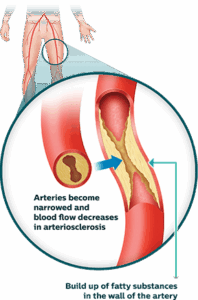Tired Legs or Something More? How to Tell if It’s Peripheral Artery Disease (PAD)

Most of us expect to slow down a bit as we get older. But if walking even short distances leaves your legs aching, cramping, or feeling weak, it might not be just aging—it could be peripheral artery disease (PAD).
PAD affects more than 6.5 million Americans over age 40, according to the CDC, yet many don’t know they have it. That’s because the symptoms often come on gradually and can be mistaken for arthritis, overuse, or “just getting older.” But left untreated, PAD can lead to serious complications—including heart attack, stroke, and even limb loss.
Here’s what you need to know.
What Is PAD?
Peripheral artery disease is a condition where the arteries that carry blood to your limbs—most often your legs—become narrowed or blocked due to plaque buildup. This restricts blood flow and causes muscles to cramp or ache when you walk, climb stairs, or even rest.
PAD is a form of atherosclerosis (hardening of the arteries), and it’s a red flag for your overall cardiovascular health. In fact, the National Institutes of Health reports that people with PAD have a 6 to 7 times greater risk of heart attack, stroke, or death from cardiovascular disease.
As Dr. Joshua Beckman, president of the Society for Vascular Medicine, puts it:
“PAD is a warning sign that should not be ignored. It often reflects widespread atherosclerosis throughout the body.”
Common PAD Symptoms
PAD symptoms can range from subtle to severe, and not everyone experiences them the same way. Some of the most common signs include:
- Leg pain or cramping with activity that improves with rest (called claudication)
- Numbness or weakness in the legs
- Coldness in one leg or foot compared to the other
- Slow-healing sores or wounds on the legs or feet
- Shiny skin or hair loss on the legs
- Weak or absent pulses in the feet
Here’s the tricky part: 1 in 4 people with PAD don’t have symptoms at all, according to the American Heart Association. That’s why awareness and screening are so important—especially if you’re in a higher risk group.
Are You at Risk?
PAD is more common after age 50, and your risk increases if you:
- Smoke or have a history of smoking
- Have diabetes
- Have high blood pressure or high cholesterol
- Have kidney disease
- Have a family history of vascular disease
- Are African American (PAD is more prevalent in this population)
If you fall into any of these categories, even without symptoms, a vascular screening could make a big difference.
How PAD Is Diagnosed
PAD can often be diagnosed through a noninvasive test called an ankle-brachial index (ABI), which compares the blood pressure in your arms and legs. If blood pressure is significantly lower in the legs, it could indicate restricted blood flow.
Sometimes, additional imaging like ultrasound or angiography is used to confirm the diagnosis and guide treatment.
You’ve Got Treatment Options—And They Don’t All Involve Surgery
The good news? PAD is treatable. At TRA Endovascular, we offer minimally invasive procedures that improve blood flow and get you back to the things you love—without major surgery or long recovery times.
Some of the options we use include:
- Angioplasty: A tiny balloon is threaded into the narrowed artery and inflated to open it.
- Stenting: In some cases, a small mesh tube is placed to keep the artery open long-term.
- Atherectomy: A small device is used to gently remove the built-up plaque inside the artery walls.
These procedures are typically done on an outpatient basis, with shorter downtime and excellent results.
What Happens If You Ignore PAD?
PAD can significantly impact your mobility, independence, and quality of life. The Society for Vascular Surgery notes that even moderate PAD can make it difficult to walk to the mailbox, go grocery shopping, or enjoy outdoor activities.
Worse, untreated PAD can lead to serious complications like infections, ulcers, and in extreme cases, amputation.
But it doesn’t have to get to that point. As the American Heart Association reminds us:
“Early detection and lifestyle changes can slow the progression of PAD and significantly improve quality of life.”
Take the First Step Toward Relief
If your legs are cramping, aching, or just don’t work like they used to—don’t chalk it up to aging. PAD is common, manageable, and treatable with the right care.
✅ Call today to schedule a vascular screening
✅ Meet with an endovascular specialist—no referral needed
✅ Get back to walking, moving, and living without leg pain
We’re here to help. At TRA Endovascular, our team specializes in diagnosing and treating PAD with minimally invasive care that puts you first.
Take the First Step Toward Relief
Fill out the form below, and we will have someone reach out to you to schedule the time of your virtual screening.
